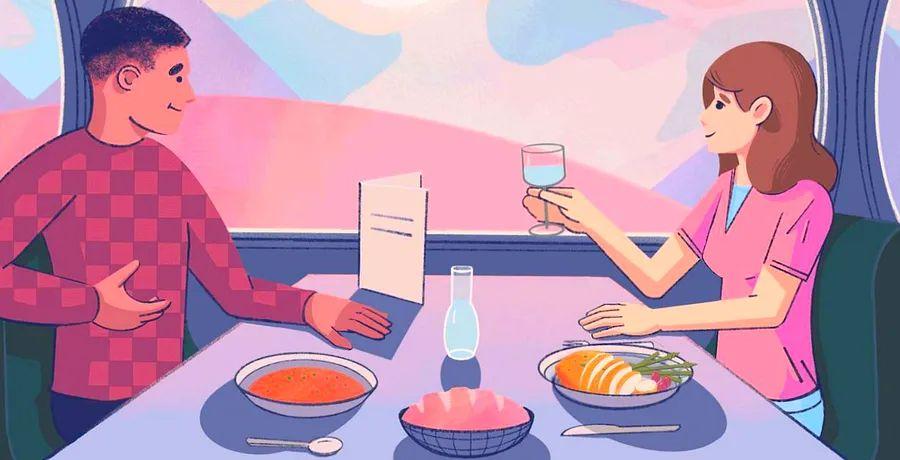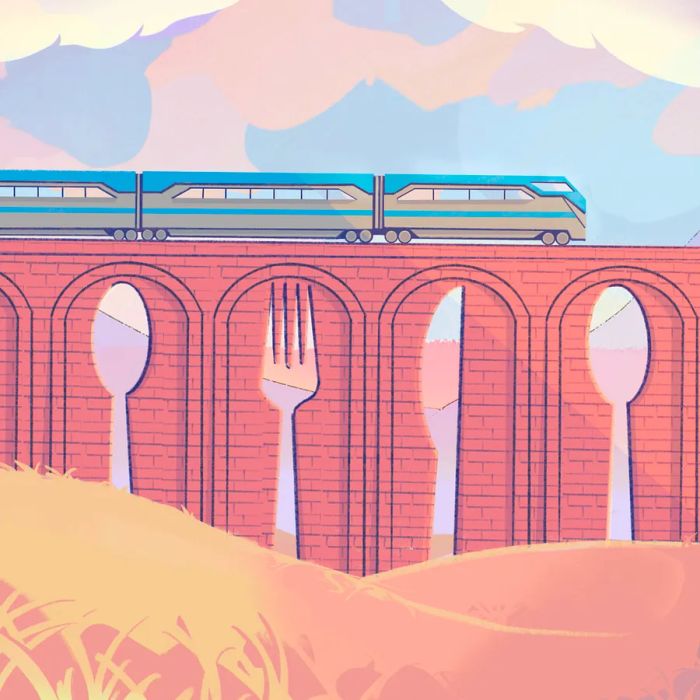The Comeback of the American Rail Dining Car

In August 2005, I took an Amtrak overnight journey from Chicago to Schenectady, New York, aboard the Lake Shore Limited. I spent the night at a table in the lounge car, eagerly awaiting breakfast at 6:30 a.m., alongside three other solo travelers.
Among us was a Brooklyn-Irish merchant marine who couldn’t stop boasting about his escapades in port, a middle-aged man in a Chicago Cubs jersey recounting gruesome tales from his street gang days when he was ‘the leader of a thousand men,’ and a retired civil servant from Harlem. He initially approached the table to tell the Cubs fan that his stories were ‘terrorizing’ an Amish family nearby. ‘I’m from the street too and I’m not impressed,’ he declared, though he was clearly intrigued by the merchant marine’s duffle bag filled with whiskey nips, which led him to join us. The Amish family and a few other anxious eavesdroppers eventually left, and we found ourselves loudly conversing around the table in an otherwise empty car, only quieting when the porter passed by, until dawn broke and the track lights dimmed.
At exactly 6:30, the four of us stumbled into the dining car and settled at a table adorned with china and flatware on a crisp white tablecloth, a rose gracing the window. The menu featured a mouthwatering image of powdered thick French toast topped with berries and cream, which I eagerly ordered. A waiter soon delivered my meal, accompanied by bacon, eggs, pastries, and coffee, all freshly prepared by the onboard chef. As we glided alongside the Erie Canal under the morning sun, our idle chatter transformed into meaningful discussions about pivotal moments in our lives and the anticipation of what lay ahead. We entered the dining car as strangers, but by the time we left, we had shared not only a meal but our stories and hopes for the future. I believe that connection wouldn’t have been possible without the comforting experience of a hot meal on a moving train.

The enchanting communal breakfast I enjoyed back in 2005 likely marked the beginning of the decline of traditional rail dining as we know it. In 2017, Amtrak appointed Richard Anderson, a former Delta Airlines executive, as its new CEO—his culinary commitment was questionable at best—amid Congressional demands to cut food service losses from the national rail service. Amtrak has historically operated at a deficit and relies on government subsidies to sustain operations. By 2018, traditional dining services were eliminated on two lines, with several more following suit the next year. It seemed passengers had little interest in conventional train dining. In 2019, Peter Wilander, Amtrak’s then-vice president of product development and customer experience, told the Washington Post that millennials prefer more privacy and dislike the discomfort of sharing tables with strangers.
During this transition, I took my second long-distance train trip, this time to fulfill my 4-year-old son Marcel’s dream of riding a ‘night train.’ It was the same route I’d traveled 14 years earlier, now headed to Chicago. I had spent weeks building excitement about the ‘train restaurant,’ and I knew he’d be thrilled by the sight of cooks bustling in the galley, grilling steaks, and calling out orders while pots and pans clanked above. This was before the pandemic, so I also mentioned we’d likely share a table with some interesting people. When dinner time arrived, he dashed ahead toward the dining car, enthusiastically kicking the green OPEN buttons at the vestibules, and then raced onward. We reached the cafe car, Amtrak’s à la carte snack bar, which typically lacks excitement or appealing food. When I asked a porter about the dining car, he shook his head and said, ‘They got rid of that on this line.’ I expressed my disappointment and reminisced about the lovely table settings and thick French toast; he raised his hand, glanced away, and replied, ‘Man, don’t even talk about it.’
Instead, Marcel and I were about to experience what Amtrak now calls ‘flexible dining service’—microwaved meals served in black plastic trays, reminiscent of airplane food, that are easy to take back to your sleeper and consume alone. I ordered a plastic tray of limp charcuterie, assuming it would be spared the microwave treatment. Dinner is included for sleeper car passengers, and they even offer an alcoholic drink. I opted for Maker’s Mark, feeling it served as an apology, reminiscent of the whiskey nips from that nostalgic train ride. Marcel settled for a bag of Goldfish and a tube of Go-Gurt, and we returned to our roomette to assemble a wooden grasshopper kit before bedtime. I hoped for a decent breakfast the next morning, but we awoke to dried Jimmy Dean breakfast sandwiches in plastic bags. In what seemed to be a promotional video, Madison Butler, communications manager for the Rail Passengers Association (RPA)—the train advocacy group that helped Amtrak get established—who is also a chef, attempted to dress up the breakfast sandwich with mustard and mayonnaise packets, stating, ‘I’m not gonna say it’s a bad experience... but I am gonna put more mustard on my sandwich.’ Ultimately, we chose to skip the train breakfast and waited for lunch in Chicago.
If you’ve taken a long train ride in the U.S. recently, especially during the pandemic when flexible dining became the norm, your dining experience likely resembled this—an unfortunate blend of airplane food without the speed and convenience of actual air travel. However, there may be hope on the horizon. In June, Amtrak announced the return of traditional dining on select trains. Currently, it’s available only to sleeper car passengers on most routes, but expansion plans are in the works. With a president known for taking around 8,000 Amtrak rides on his D.C. to Delaware route, and Democratic representatives like Tennessee’s Steve Cohen reminiscing about childhood memories of railroad filet mignon, Amtrak might soon have the resources for a more substantial menu: $66 billion has been allocated for Amtrak in the Senate-passed infrastructure bill. Many communities across the nation rely on rail services for access to work, medical care, and other essential travel, but every traveler deserves quality food, especially on long journeys—and some of this funding could enhance food service.
There was a time before Amtrak that many refer to as the 'golden age' of railroad dining. From the late 19th century until the Great Depression, American railroads offered regional cuisines that could rival the finest restaurants in the nation. In 1925, railroads served approximately 80,000 meals daily, as noted by Jeri Quinzio in her book, Food on the Rails.
According to Dining by Rail author James Porterfield, Midwestern trains provided freshwater fish from the Great Lakes while East Coast trains featured saltwater varieties from the Chesapeake Bay. The Union Pacific Railroad reportedly spent four years searching for the perfect raspberries in a small Utah valley. The Chesapeake and Ohio Railway served a 'Chesapeake Bay fish dinner' — a casserole layered with local flounder, oysters, potatoes, and white onions, all topped with a cream sauce. One Colorado railroad treated passengers to fried mountain trout with brown butter and julienne potatoes against the backdrop of the Rockies. Jessica B. Harris, in the Chicago Tribune, highlighted how southeastern menus reflected the influence of Black rail chefs, featuring dishes such as 'ham with pineapple fritters, plantation beef stews, biscuits, cream of peanut soup, baked sweet potatoes, and scalloped oysters.'
Unfortunately, maintaining that level of luxury was expensive — in 1925, trains allocated $10.5 million to food service, as noted by Quinzio. To cut costs, managers began underpaying and overworking Black cooks and porters, a practice that started right after the Civil War. An 1886 article in the New York Times reported that porters often worked 37-hour shifts for a meager $16 a month, while covering the costs of their own uniforms ($18 each) and meals.
According to Butler from the RPA, inequality was just as prevalent in the dining car. 'The upper classes dined in those elegant cars while everyone else was back in steerage.' I would never have had the chance to share a table with such diverse individuals as I did in 2005. Butler believes our romanticized view of this so-called golden age has hindered the adaptation of dining cars to modern needs. 'We must move away from the overly lavish bourgeois narrative surrounding dining cars, as it's simply not sustainable,' they stated. 'There is a feasible middle ground between indulgence and TV dinners that should be expected on overnight trips. Through publicly funded infrastructure, we can provide a better experience for everyone without being extravagant.'
Butler, who travels extensively on Amtrak for their role with the RPA, shares that their most meaningful dining experiences have come from sharing meals with strangers, like the occasion they enjoyed a bottle of wine with an 84-year-old widow who was exploring the country with just three suitcases after selling her condo. 'Train travelers are different,' they said. 'They aren’t in a rush and tend to interact in ways you wouldn’t see at an airport. I’ve witnessed many people who usually wouldn't connect engaging with one another in that unique space on board.'
Butler’s organization, the RPA, was established in 1968 as the National Association of Railroad Passengers to advocate for a national rail system that would replace the struggling private railroads as air travel gained popularity in the late 1950s and ticket sales dwindled. By 1965, only 10,000 passenger cars were still operating, a staggering 85 percent decrease from 1929. In a bid to cut labor costs, the New York Central line introduced the Meal-a-Mat vending machine, allowing passengers to buy classic railroad dishes like lobster Newburg and heat them in a 'radar oven' (essentially a microwave). If you’re curious about the experience of eating rubbery microwaved seafood on a train, just sample the sesame-glazed salmon on any Amtrak train offering flexible dining today. The end of the private passenger railroad era was imminent.
In 1967, the railroads lost their contracts for first-class mail with the U.S. Postal Service and plummeted into crisis. The RPA successfully pushed for the establishment of the National Railroad Passenger Corporation, known today as Amtrak. With funding from Congress, Amtrak took control of most privately owned passenger railroads in 1971 and acquired 140 dining cars. By 1983, the remaining railroads had either shut down or transferred operations to Amtrak. While Amtrak passengers didn’t enjoy seven-course meals with swordfish mains as they did on private lines in the 1920s, they were well-fed, dining tables were accessible to all, and workers were treated with grMytour respect.

I asked Robert Wiggins, an African-American chef on the Capitol Limited train running between D.C. and Chicago in the 1980s, whether he enjoyed his work. 'I loved it,' he replied, reminiscing about the 'good union protection' and creative freedom in the kitchen. He prepared all of his sauces from scratch, crafted menus on the fly, and advised the national menu-planning board. During dinner service, he typically offered strip steak, creatively stuffed flounder, and chicken dishes like cordon bleu or francese. On breaks, he would visit local gourmet shops in Chicago for special ingredients. His proudest moment came when Jesse Jackson visited the kitchen and asked, 'What have you got for me, chef?' Wiggins was prepared with ribs.
Although Amtrak’s train menus were much simpler than those of the luxurious private railroads during the golden age, they were well-executed and often reflected regional influences. For instance, a Crescent line menu from the 1980s featured wines sourced from vineyards along the route. They paired Virginia ham with orange raisin sauce with a Winter White chardonnay from Pindar Vineyards in New York. A Southwest Chief menu from the 1990s included New Mexico steamed tamales for lunch, served alongside cilantro and black beans. In the early 2000s, Amtrak began forming a Culinary Advisory Team comprising chefs who would gather each spring to develop dishes in a test kitchen. James Beard Award-winning chef Jamie Bissonnette collaborated with chefs Roberto Santibañez and Matthias Merges in 2017. Bissonnette recounted, 'Matthias created a fantastic ramen dish for one of the white-tablecloth long-distance trains. There was Moroccan beef with chickpea salad and harissa barbecue sauce, plus a shrimp biryani. [The biryani] was so good that I adapted the recipe for one of my restaurants.' Bissonnette’s Indian spiced shrimp biryani had a brief run on the menu before the serious food service cuts began.
Similar to private railroads, Amtrak’s food service program has historically operated at a loss; it hasn’t turned a profit since its launch in 1971. Butler explains, 'Some believe ticket sales cover the costs, but it isn’t structured to be a profit-driven enterprise. It functions more like a national service, akin to the post office or a library.' This view isn’t universally accepted. In 2012, Florida Rep. John Mica criticized Amtrak for incurring $833 million in food service losses over the previous decade. In 2015, he included provisions in the surface transportation law mandating Amtrak to devise a strategy to eliminate losses from food and beverage services within five years. Then came Anderson from Delta.
Controversial as it was, the new CEO swiftly achieved the best financial results in Amtrak’s history by implementing layoffs, enhancing the reliability of short-haul trains along the East Coast, and offering appealing prices for group and sleeper car passengers. However, his decision to eliminate traditional dining sparked outrage among labor unions and rail passenger groups, inspiring extensive discussions in last year’s House Democratic infrastructure bill regarding Amtrak’s food service. A Change.org petition for the restoration of traditional dining garnered over 157,000 signatures, and Rep. Cohen received 118,000 written complaints about its discontinuation. RPA CEO Jim Mathews conveyed to Anderson during a November 2019 House Transportation and Infrastructure Committee meeting, 'It’s not just about the food... It’s about the experience of connecting with others on the train over a shared meal.' Later that month, Anderson remarked to a Boston public radio station, 'Our biggest challenge is when I testify in Congress, all we discuss is French toast on dining cars.'
Anderson departed from Amtrak after his three-year contract concluded, paving the way for new leadership under CEO William Flynn and President Stephen Gardner. Butler notes that Gardner 'has an excellent vision for long-distance routes' that could potentially be realized with support from both state and federal governments, as well as the private railroads whose tracks Amtrak utilizes.
Robert Jordan, Amtrak’s VP of customer service stations and onboard operations (including food service), reported that since the revival of traditional dining on select routes in June, 'Our customer satisfaction index has surged by 20 percent.' The new menu features several vegan and gluten-free options, more appetizers, such as lobster crab cakes on farro with butternut squash and a vegetarian tamale with Hatch chiles and cheese. Main courses now include the Angus flat iron steak and a pesto cream tortellini dish. LA-based Amtrak chef Frank Villasenor noted an increase in the 'marbling' of the steaks provided, along with fresher vegetables, a wider array of colorful garnishes, spices, and sauces, as well as edible flowers to enhance the presentation of desserts like chocolate tortes, cheesecakes, and carrot cakes. 'On a plate-by-plate basis, traditional dining is on par with flexible dining costs,' says Jordan. He adds, 'For overhead costs, we had to remove payroll from the equation, as Congress mandated the reinstatement of all furloughed food service workers from the pandemic.'
If positive feedback and Congressional backing persist, Jordan anticipates the next steps will involve reintroducing traditional dining to coach passengers and eventually restoring it to the East Coast routes.
In the end, the future of traditional train dining hinges on the preferences of passengers. We'll discover in the coming years if Wilander, Amtrak’s former VP of customer experience, was correct in asserting that younger generations prefer solitary meals. Personally, as an elder millennial, I find that untrue. I likely won’t board a train again until traditional dining returns to routes from New York. I hope it happens soon so my son can relish the joy of train dining before he reaches an age where he'd prefer to retreat to a roomette with his phone. If support for Amtrak and its dining cars fades with the oldest generation, we might lack advocates to challenge unfavorable decisions from future CEOs or Congress. In such a scenario, we would lose traditional train dining and the rare opportunity for diverse individuals to connect. However, I'm not pessimistic; train rides are lengthy, Wi-Fi is unreliable, and if the food is appealing, people will be encouraged to step away from their devices, head to the dining car, and enjoy a meal together.
Mike Diago is a social worker, writer, and cook based in the Hudson Valley of New York. Jarred Briggs is a freelance illustrator from New Brunswick, Canada, who enjoys creating vibrant conceptual illustrations.
Evaluation :
5/5



